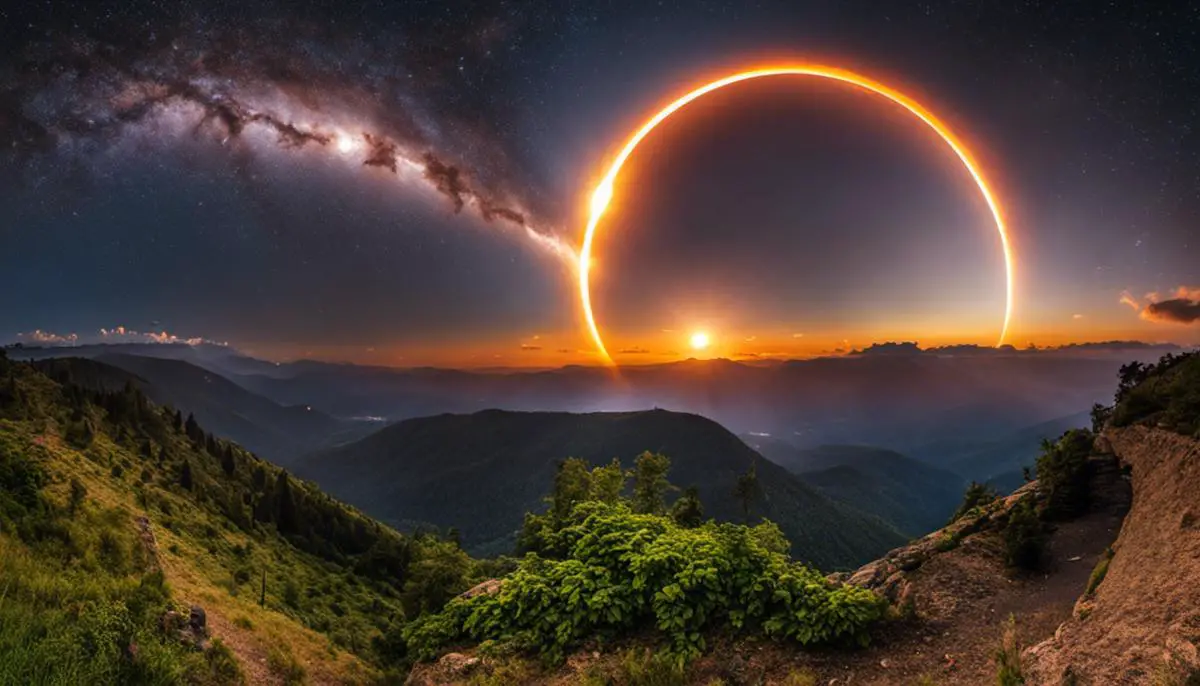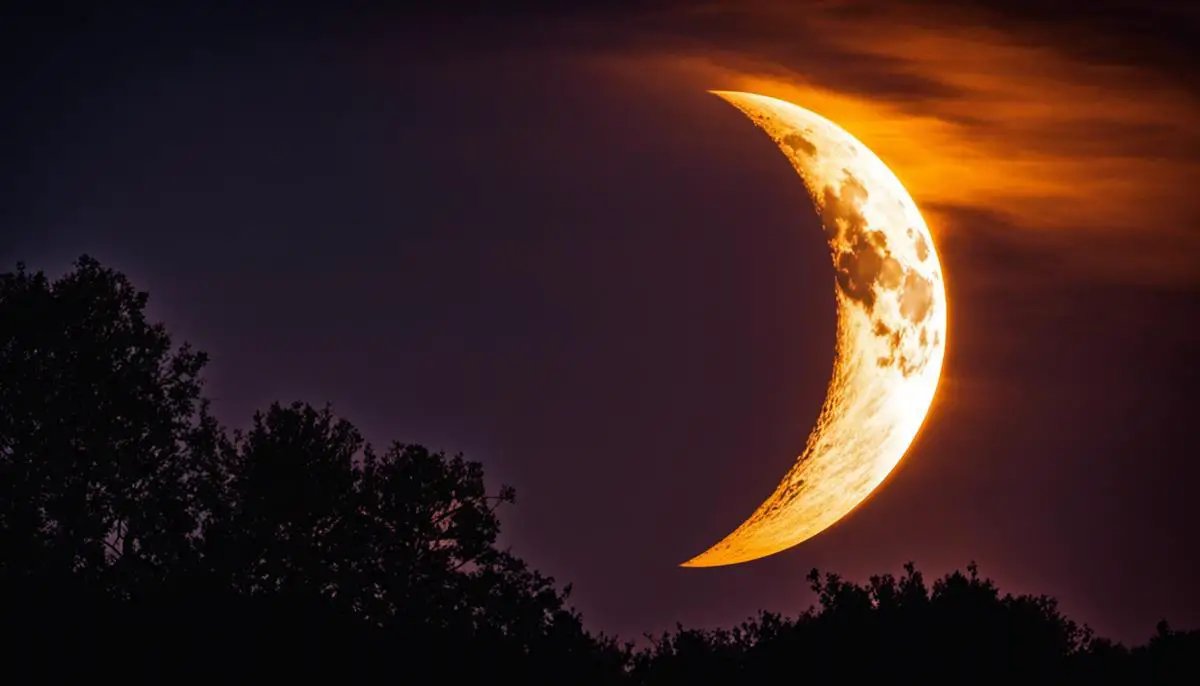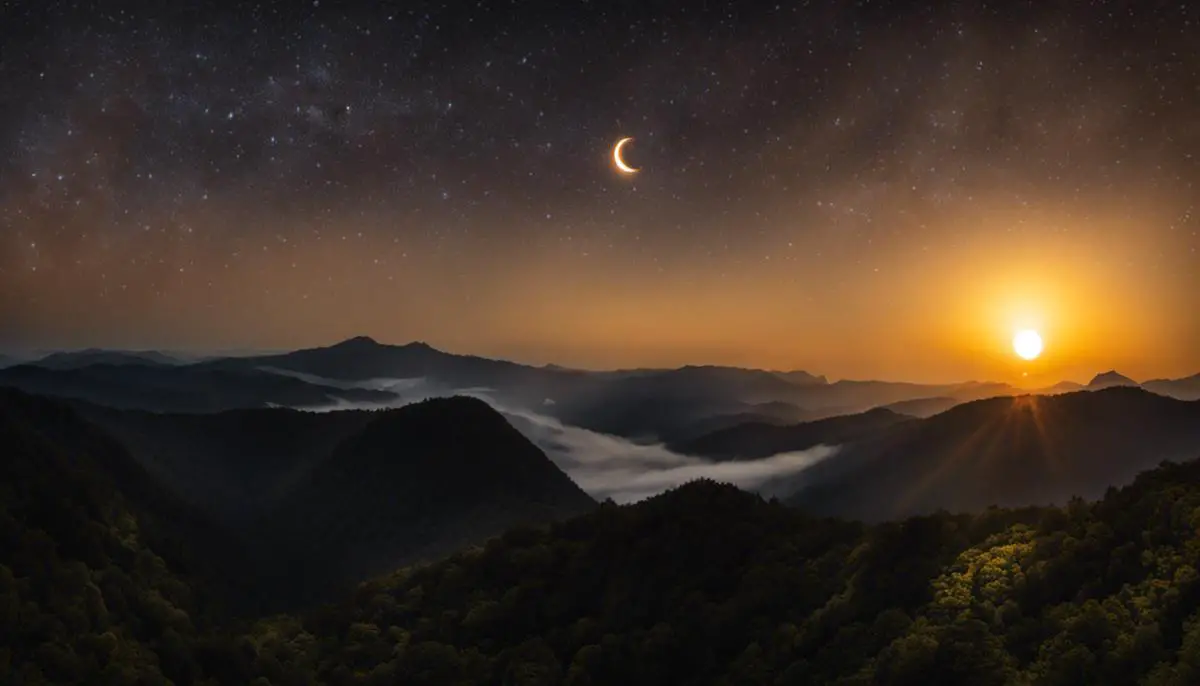There is a peculiar beauty to annular solar eclipses as they transform our familiar sun into a breath-taking ‘ring of fire’. The upcoming annular solar eclipse in 2023 incites anticipation for astronomy enthusiasts and the general public alike, with its potential for stunning views and the unique spectacle it offers. Whether you’re a seasoned eclipse-chaser or looking forward to your first astronomical event, knowing why annular eclipses occur and the best locations to view the forthcoming eclipse is crucial. Additionally, understanding the necessitated safety measures and having a few essential viewing tips up your sleeve ensures an unforgettable, insightful, and secure eclipse experience.
Understanding Annular Solar Eclipses
When enthusiasm for celestial events and phenomena abounds, few happenings can elicit as much fascination as an Annular Solar Eclipse. The uncanny majesty of an otherworldly celestial ring has captured the hearts of hobbyist astronomers across the globe, spurring countless late-night vigils in pursuit of this remarkable display.
An annular solar eclipse, despite its enticing mystique, is rooted in the bounds of cosmic mechanics. This event stems from the Earth, Moon, and Sun aligning in such a way that the Moon blankets the majority of the Sun. Unlike a total solar eclipse where the Moon entirely obscures the Sun, an annular eclipse leaves a visible, fiery ring known in Latin as the “annulus” or “ring of fire“.
The real puzzle lies within the question, “Why doesn’t the moon block out the Sun entirely?” Well, here’s where the beauty of celestial distances plays its role. The Moon’s orbit around Earth isn’t a perfect circle—it’s an ellipse, with varying distance highs and lows. When an eclipse occurs during the Moon’s apogee (the farthest point on its orbital path from Earth), the Moon appears smaller in the sky and fails to obscure the Sun completely. This small visual difference lends the event its distinct “ring of fire” characteristic.
Falling under the spell of an annular solar eclipse is of little surprise when considering its rarity. These events, although following an 18-year Saros Cycle, are usually visible from different parts on the globe, making the chances of witnessing one from your backyard rather slim. However, when the opportunity strikes, it’s necessary to exercise absolute caution. This celestial spectacle, although awe-inspiring, is dangerous to observe directly, presenting the risk of severe eye damage or even blindness. For safe viewing, opting for a solar filter for telescopic devices, eclipse glasses, or employing a pinhole technique is advisable.
Hunting down these cosmic occurrences isn’t for the faint-hearted, but such is the thrill of the chase, right? So, brave hobbyist astronomers, keep your gear at the ready, consult your eclipse maps, and anticipate the next breathtaking spectacle our incredible universe has to offer. After all, nothing compares to the feeling of witnessing an annular solar eclipse firsthand: the humbling sense of insignificance in the grand cosmic scheme, dwarfed by the fiery ring hanging boldly in the sky. Indeed, it’s a sight that tethers the mind to the eternal expanse of the cosmos, etching an unforgettable mark on the astronomical enthusiast’s heart. In essence, an annular solar eclipse is not simply special—it’s utterly extraordinary.

Preparation for Solar Eclipse Viewing
The Must-Have Gear for Safe and Spectacular Annular Solar Eclipse Viewing
Moving from the delightful interlude of anticipation and preparation for an annular solar eclipse, it’s vital to understand the pertinent tools required for this thrilling celestial event. Engaging with eclipse-viewing involves a certain degree of safety consideration, which necessitates specific types of equipment. Fortunately, many of these items are readily available and not overly expensive, making eclipse-chasing a more accessible pastime for astronomy enthusiasts worldwide.
First and foremost, solar viewing or eclipse glasses are the absolute necessities. Constructed specifically for safe solar observation, these glasses are designed with special-purpose solar filters that not only provide an optimal viewing experience but also prioritize the health of your eyes. They’re not the same as regular sunglasses – those are not nearly enough to protect your sight from the intense solar rays that occur during an annular eclipse. Remember, quality and safety are paramount here, so ensure that the eclipse glasses adhere to ISO 12312-2 international standards for safe direct sun observation.
A solar filter for your camera or telescope comes highly recommended for those interested in stargazing and photography. Similar to the eclipse glasses, these filters are designed to protect your equipment’s lens from intense rays as well. While some enthusiasts use a spotter scope or binoculars during the eclipse, make sure they’re also equipped with reputable solar filters.
For an even more refined viewing experience, consider investing in an H-Alpha telescope. Such a high-tech gadget allows the observer to delve deeper into the sun’s dynamic surface, capture better images, and take an unparalleled cosmic journey during the annular eclipse. But remember, even with the H-Alpha telescope, safe viewing should utilize an added solar filter.
When it comes to comfort during the event, a simple lawn chair and weather-appropriate clothes will do. Surprisingly, the temperature can drop significantly during an eclipse, especially if you’re in an open space with nothing to block the wind. Layers are the solution to this challenge, allowing adjustment with the changing environmental conditions.
Adjacent to the list of necessary equipment, there’s an undeniably critical element to the ultimate annular eclipse viewing experience: planning! With the right spot carefully picked, decent weather, exact timing, and equipped with all the necessary gear, audiences are ready for a mesmerizing visual experience. This preparation only serves to add to the depth of appreciation for these rare celestial events, turning spectators into passionate cosmic hunters relishing the beauty of the sun and moon’s intricate dance.
Enjoy, stay safe, and remember: this dance of celestial bodies, captivating as it is, also serves as a humbling reminder of our small yet significant place in this grand cosmic ballet. Every moment cherished under the protective equipment can make the annular eclipse a lifelong memory, etched deeply in the annals of personal astronomical conquests.

Best Locations for Viewing in the U.S.
Unveiling the Best Locations and Provisions for the 2023 Annular Solar Eclipse
Having a front-row seat to the celestial ballet is nothing short of captivating. The 2023 annular solar eclipse is a highly anticipated event increasing in hype as all stargazers and thrill-seekers eagerly jot down their viewing agendas. Seeking the ideal locations around the United States will not only enhance this stellar spectacle but also amplify its unique beauty.
Let the kaleidoscope course of the 2023 annular solar eclipse begin in Oregon, a state known for its contrasting landscapes. The eclipse starts its wondrous journey here, offering a remarkable viewing opportunity against Oregon’s beautiful backdrop of mountains, valleys, and coastline. This is a golden chance to experience a rare eclipse amidst inspiring natural scenery.
Next, the path of annularity ventures through Nevada, taking in the expanse of its arid deserts and craggy mountain ranges. Nevada’s typically clear skies are a bonus here, providing potential for an unmarred view of this breathtaking spectacle.
From Nevada, the assertive shadow of the moon stretches to touch Texas, allowing spectators to view the eclipse against a backdrop of wide plains, sprawling ranches, and high deserts. The spectacle concludes in Texas, ensuring that viewers in the Lone Star State can enjoy an unobstructed view of the beautiful ring of fire.
For those embedded in the urban labyrinth, ample opportunities abound! Cities along the eclipse path include Reno in Nevada, and Dallas and Lubbock in Texas. Blessed with breathtaking skylines, these cities offer a unique blend of nature’s marvel against an urban landscape, making the eclipse a truly cityscape artwork.
That said, one can’t neglect the importance of timing the viewing to perfection. The ideal time to watch this stellar show is during the maximum eclipse, when the moon is closest to the center of the sun. This timing, of course, depends on the location, so make sure to meticulously plan out the schedule.
It’s vital not to neglect the weather. Overcast skies can prove to be a buzzkill, so tracking weather forecasts diligently in the running up to the event is of essence. First-row seats at celestial phenomena require clear, unobstructed skies for an unforgettable experience.
Trotting around the country chasing astral phenomena might not be for everyone. Luckily, livestreams offer the comfort of witnessing the eclipse from anywhere. These streams, mostly aired by astronomical societies and news outlets, offer detailed commentary, making the experience both enlightening and entertaining.
Remember, the pursuit of annular solar eclipses isn’t just about the event itself. It’s about the journey, the anticipation, the camaraderie with fellow enthusiasts, and the profound reflections that come with witnessing nature’s grandeur. It’s about stargazing through passion-tinted glasses and engaging intentionally with the cosmos. Make it count!

International Viewing Locations
As passionate pursuers of celestial spectacles, the next stop after the United States for viewing the 2023 annular solar eclipse is the vast expanse of Latin America. With this being said, take note, a keen astronomer knows that researching and careful planning for an optimal viewing experience are crucial steps not to be overlooked.
While the moon casts its shadow, we head south to Mexico. Guadalajara, a city blessed with an average of 210 sunny days a year, ranks high on the list. Besides its favorable climate, it offers panoramic cityscape views from beautiful local landmarks, such as the Hospicio Cabañas. It could be a great opportunity to pair the celestial event with exploring rich local art and culture.
Next, the eclipse’s path broadens its reach to the Central American countries of Guatemala and Honduras. In Guatemala, the well-preserved Mayan site of Tikal could be a mesmerizing setting for a sky-gazing fest, as you experience the “ring of fire” in unison with the ancient pyramids. Roughly at the same time, the temple ruins of Copan in Honduras promise a breathtaking show against a backdrop of intricate hieroglyphs.
Venturing further south, the eclipse brightens Ecuador and Peru’s skies. In Ecuador, Quito, with its close proximity to the equator, offers its city escarpments for renewed wonder at celestial beauty. As for Peru, the carefully aligned stones of Machu Picchu seem to anticipate the cosmic spectacle. Imagine being surrounded by the grandeur of Inca civilization while beholding the beauty of the eclipse.
Across the Atlantic, Madagascar is in line to stage the Grand Finale. Among its lush rainforests and dramatic landscapes, the celestial stage is set for a memorable experience. The breathtaking canopy of Ranomafana National Park or the expansive vistas atop the ‘Avenue of the Baobabs’ are both inspiring locations to take in the closing moments of this cosmic spectacle.
Given the pandemic’s still-looming presence, it’s crucial to stay tuned to travel advisories and local guidelines. It’s also recommended to check eclipse visibility maps and localized weather reports closer to the event to avoid cloud cover disappointment. With this in mind, an interactive globe at hand would be highly beneficial for tracing the eclipse path and planning accordingly.
This global chase of the cosmic phenomenon underlines a universally shared awe for the mysteries of the cosmos. The 2023 annular solar eclipse, while a thrilling celestial event, is also an opportunity to explore different cultures, historical locations, and unique landscapes.
Astro-enthusiasts buckle up for this grand celestial road trip! Remember, the night sky is a global theater; all we need to do is look up and marvel at its show. Despite geographical locations and time zones, when we gaze up at the cosmos, our heads tilt back in unison, our eyes sparkling with the same celestial delight. This unifying hobby traverses international borders and highlights our shared fascination with the universe’s empyreal beauty.

Handy Eclipse Viewing Tips & Techniques
Adding a New Dimension: Pinhole Projection
Surely, we’ve talked about the ‘ocular joy’ that comes from direct viewing an annular solar eclipse. But, there’s another surprisingly simple method that taps a different kind of magic – Pinhole Projection.
Even some seasoned eclipse-chasers don’t know this method. Using a simple pinhole projector, viewers can marvel at the wonder of an eclipse in a unique and immersive way. This homemade device projects the sun’s image—forming a reversed and shrunken, but still distinctly visible “Ring of Fire”—onto a sheet of paper or on the ground.
Getting the Details Right: Smartphone Zoom Apps
In today’s digitally connected world, our smartphones accompany us almost everywhere, including an eclipse viewing event. Here’s the kicker. Some specialized apps can provide a digital zoom far better than one might assume possible from a smartphone camera. That extra zoom can make the difference between a mundane rooftop observation and an up close, intricately detailed display of this celestial wonder.
Optimum Exposure: Use HDR Mode
Another gem from the tech world: High Dynamic Range (HDR) mode. Most modern smartphones and digital cameras have this functionality. Using HDR mode will balance the faint moon and bright solar corona, resulting in a more detailed and visually appealing image.
Unconventional Tool: Welder’s Mask
Block out unnecessary solar light with a tool not customarily found in an astronomy enthusiast’s kit – a welder’s mask. A high-quality welder’s mask complements regular eclipse glasses, helping to highlight the glow of the eclipse more vividly by blocking unwanted ambient light.
Timely Reminder: Avoiding ‘Eclipse Blindness’
As part of our safety guide, let’s remind viewers of a less-known piece of information: Looking directly at the sun before and after totality – even for a few seconds – might potentially cause ‘eclipse blindness.’ This temporary or permanent impairment could be avoidable by adhering to strict viewing guidelines. Painstaking, but surely, prevention beats cure.
Harmonic Confluence: Beauty of Nature Frames
While certainly the eclipse is center stage, the surrounding environment can enhance the viewing experience. The silhouettes of trees during the period of maximum eclipse provide a natural pinhole effect for a stellar view. Embrace the topography of the local area and use natural frames like mountains, monuments, or bodies of water as foreground for breathtaking photographs.
Stellar Fusion: Combining Astronomy & Astrology
Though finding it on the fringes of scientific exploration, many eclipse viewers draw personal significance and inspiration from the astrological interpretations of these cosmic events. Having a star chart handy at the viewing site can add a fun, mystical element, and provide a possible blueprint for inner journeys paralleling our celestial pursuits.
Utilizing Community: Harnessing Local Resources
Scope out local academic institutions, astronomical societies, and stargazing clubs. Collaborating with these helpful resources often results in awesome viewing gatherings, secret location tips, shared equipment, and enriches the sense of community that eclipse viewing garners.
The beauty here is that there’s no one-size-fits-all when it comes to viewing an annular solar eclipse. Feel free to be as minimalistic or as extravagant as wanted. In the end, viewing and appreciating these celestial performances are as individual as our fingerprints. Embrace the uniqueness and prepare for a spectacle that will etch its mark on the canvas of memory forever. The stars are aligning, and we are all but spectators in nature’s grand cosmic theater.

Whatever your approach to observing the 2023 annular solar eclipse might be, the joy is found in the shared admiration for this extraordinary celestial phenomenon. Discovering the perfect site can make all the difference between a regular day and an astonishing astronomical journey, be it in the heartland of America or internationally. So, grab your eclipse glasses, ensure your equipment is all set, and embrace the awe-inspiring ‘ring of fire’ moment. After all, witnessing an annular solar eclipse is a unique and humbling reminder of our small but significant place within the vastness of the cosmos.
![]()
